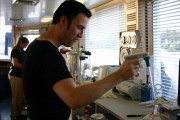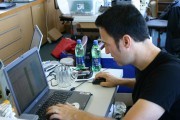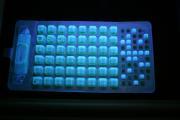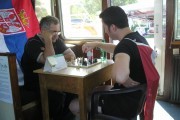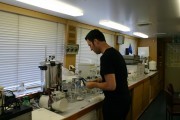
In terms of scientific results, based on measurements of Escherichia coli and Enterococci, he found that most stretches in Germany and Austria fell into the category of "excellent bathing water quality", according to the EU Bathing Water Directive of 2006 (E.coli < 500 MPN/100ml; ENT: < 200 MPN/100ml), with the exception of the Austrian stretches from Linz to Ybbs and after Vienna. Values fell into the category of "sufficient quality" from Hainburg at the Austrian border to Bratislava, Slovakia. Conditions improved after Gabcikovo with the exception of some severely polluted tributaries (e.g. Mosoni: ECOLI: 55000MPN/ 100ml). The Danube after Esztergom, Hungary, showed excellent bathing water quality until Budapest, after which a steep increase from 40 to 86000 MPN/100ml (E.coli) and from <38 to 2500 MPN/100ml (ENT) was registered. Until Belgrade, the Danube had "insufficient bathing water quality" (1000 - 6000 ECOLI) with only a few exceptions, while some tributaries showed better results.
As for his experiences in the Argus lab: "For a microbiologist, it was a lot of work," he says, requiring about three hours per sampling station with two to four stations per day under deck. "There were not many possibilities to enjoy the landscape."
While ECOLI and ENT could be measured on board, Kirschner performed some preliminary steps for the rest of the parameters (bacterial growth, total bacterial numbers, DNA filtration for bacterial community analysis and human and animal faecal marker detection, dissolve organic carbon analysis), which were then refrigerated or frozen for further analysis at the inland labs. In Belgrade, where Kirschner was replaced by fellow Austrian Branko Velimirov, all of the samples were downloaded from the ship to a car that went to Vienna. There, samples were distributed to three labs: the Medical University Vienna Institute of Hygiene and Medical Microbiology, under Dr. Kirschner; the Medical University Vienna, Centre for Anatomy and Cell Biology, under Prof. Velimirov; and the Technical University of Vienna, Institute of Chemical Engineering, under Prof. Andreas Farnleitner.
Beyond the science
As microbiological work needs a cool lab, there was always a "fight" with the chemists for keeping on the air-conditioning. "Carmen, you make me crazy," was what Kirschner would often say to Romanian chemist Carmen Hamchevici when she suddenly switched the cooling off.
"I was delighted by the beautiful landscape around Esztergom and Visegrad and their cultural heritage," he says. Kirschner found sleeping on the Szechenyi ship to be excellent, and the rest of the team and crew to be extremely nice people. He enjoyed his chess tournament with machinist Svetislav Mojic (nicknamed "Sefe" or "chief"), as well as the entertainment of crewman Tomislav ("Toma") Andjic. "Toma turned out to be a universal mechanic repairing everything from tap water devices to centrifuges. Even my laptop, which had suffered from a ‘coffee attack', was reanimated by Toma for a few minutes - just enough time enough to download its most important files for the JDS - all of the microbiological data gained so far - before the computer fell again into a coma."
On the other hand, being a vegetarian, Kirschner found it difficult to get a variety of foods on the Szechenyi, the crew and cooks being Hungarian with an excellent knowledge of typical Hungarian food - typically consisting of meat, potatoes and bread. "Eating at the fish restaurants on land was a nice consolation," he says.












